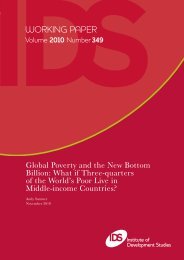Patterns of time use in Tanzania: how to make public investment in ...
Patterns of time use in Tanzania: how to make public investment in ...
Patterns of time use in Tanzania: how to make public investment in ...
You also want an ePaper? Increase the reach of your titles
YUMPU automatically turns print PDFs into web optimized ePapers that Google loves.
2. Data<br />
The TUS was undertaken by the <strong>Tanzania</strong>’s National Bureau <strong>of</strong> Statistics<br />
(NBS) <strong>in</strong> 2006 as an add-on module <strong>of</strong> the Integrated Labour Force Survey<br />
(ILFS) and is the outcome <strong>of</strong> several years <strong>of</strong> advocacy and research led by the<br />
<strong>Tanzania</strong> Gender Network<strong>in</strong>g Programme (TGNP). The survey provides a<br />
wealth <strong>of</strong> <strong>in</strong>formation on the range <strong>of</strong> paid and unpaid activities and tasks<br />
that women and men undertake dur<strong>in</strong>g a day. The broad categories mak<strong>in</strong>g<br />
up SNA work are: (1) employment for establishments, which more or less<br />
correspond <strong>to</strong> formal sec<strong>to</strong>r work (2) primary production activities not for<br />
establishments, which <strong>in</strong>cludes subsistence production as well as collection <strong>of</strong><br />
fuel and water (3) services for <strong>in</strong>come and other production <strong>of</strong> goods not for<br />
establishments, which more or less corresponds <strong>to</strong> non-agricultural <strong>in</strong>formal<br />
sec<strong>to</strong>r work. The categories mak<strong>in</strong>g up unpaid work (some <strong>time</strong> called also<br />
non-SNA or extended-SNA work) are: (4) ho<strong>use</strong>hold ma<strong>in</strong>tenance (<strong>in</strong>clud<strong>in</strong>g<br />
food preparation), management and shopp<strong>in</strong>g for own ho<strong>use</strong>hold, (5) care for<br />
children, the sick, elderly and disabled for own ho<strong>use</strong>hold and (6) community<br />
services and help <strong>to</strong> other ho<strong>use</strong>holds. Non-work activities <strong>in</strong>clude: learn<strong>in</strong>g,<br />
social and cultural activities, mass-media <strong>use</strong>, personal care and sleep. The<br />
full list <strong>of</strong> activity codes is reported <strong>in</strong> Annex 1. Methodological issues are<br />
dealt with <strong>in</strong> Annex 4.<br />
The <strong>Tanzania</strong> TUS is a very <strong>use</strong>ful and <strong>in</strong>novative dataset—the undertak<strong>in</strong>g<br />
<strong>of</strong> more such surveys should be def<strong>in</strong>itely encouraged. This survey allows us<br />
<strong>to</strong> measure work by women which goes usually undercounted <strong>in</strong> all other<br />
surveys. The design <strong>of</strong> the TUS, as an add-on module <strong>of</strong> the ILFS 2 <strong>use</strong>fully<br />
provides the opportunity <strong>to</strong> draw l<strong>in</strong>ks between gendered patterns <strong>of</strong> <strong>time</strong><br />
<strong>use</strong> and other socio-economic characteristics conta<strong>in</strong>ed <strong>in</strong> other parts <strong>of</strong> the<br />
labour survey.<br />
2 This is not typical <strong>of</strong> any TUS—<strong>time</strong> <strong>use</strong> surveys have been undertaken as stand-alone<br />
surveys <strong>in</strong> some cases and are not always draw<strong>in</strong>g on nationally representative samples.<br />
3

















